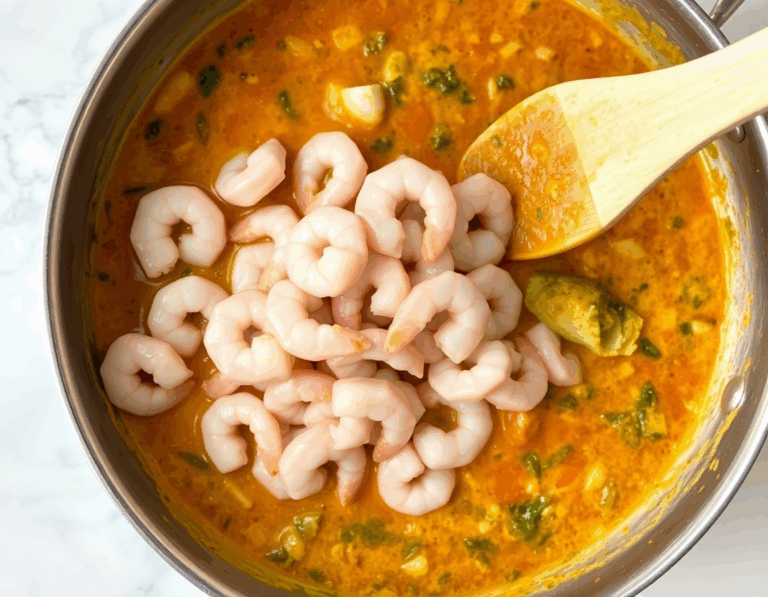There’s nothing quite like the aroma of coconut mingling with spices—it’s like a warm hug for your senses. I whipped up this Thai Coconut Shrimp Curry the other day, and let me tell you, it was like a quick vacation to a bustling Bangkok street market, minus the jet lag. Imagine creamy coconut milk dancing with curry paste and fresh shrimp—it’s a symphony of flavors that somehow feels both luxurious and comforting.
Steps
- Prepare the shrimp by peeling, cleaning, and thawing if needed. Dice the onion, slice the bell pepper into thin strips, and chop or mince the jalapeño. Adjust the amount of jalapeño and its seeds based on your spice preference.
- In a large pan, heat the oil over medium-high heat. Add the onion, jalapeño, and bell pepper, cooking for about 4-5 minutes until they are soft. Remove the veggies with a slotted spoon and set them aside in a bowl.
- Reduce the heat to medium and pour in the coconut milk, red curry paste, fish sauce, and brown sugar. Whisk these ingredients together and bring them to a gentle boil.
- In a small bowl, combine the cornstarch with cold water and whisk until smooth. Add this mixture to the sauce, allowing it to simmer and thicken for approximately 5 minutes, stirring occasionally.
- Pat the shrimp dry and add them to the sauce along with the cooked vegetables. Let the curry simmer gently, stirring occasionally, until the shrimp are cooked through and opaque.
- Taste the curry and adjust the flavors as needed, adding more heat with red pepper flakes or extra red curry paste if desired. Finish by topping with fresh Thai basil.
- Serve the curry hot, paired with your choice of jasmine or basmati rice, or refer to other serving suggestions for variety.

Ingredients
- 1 pound raw shrimp, peeled, cleaned, and thawed if frozen
- 1-2 tablespoons avocado oil or olive oil
- 1 white onion, diced
- 1 red bell pepper, cut into thin strips
- 1-2 large jalapeños, minced or sliced (adjust quantity based on desired spiciness)
- 3 tablespoons red curry paste
- 1.5 tablespoons fish sauce
- 2 tablespoons brown sugar
- 14 ounces canned unsweetened coconut milk
- 1.5 tablespoons cornstarch dissolved in 1.5 tablespoons cold water
- 2-3 tablespoons fresh chopped Thai basil for garnish
- Lime wedges for serving
- Crushed red pepper flakes, optional for extra spice, to taste
Nutritional Values
Calories: 444kcal | Carbohydrates: 20g | Protein: 27g | Fat: 30g | Saturated Fat: 22g | Cholesterol: 286mg | Sodium: 1431mg | Potassium: 474mg | Fiber: 4g | Sugar: 13g | Vitamin A: 2794IU | Vitamin C: 53mg | Calcium: 210mg | Iron: 5mg
FAQ
- Can I use a different type of seafood instead of shrimp in this curry?
- Absolutely! While shrimp is the star of this recipe, you can substitute it with other seafood like scallops, fish, or even chicken if you prefer. Just adjust the cooking time to ensure the protein is cooked through properly.
- What can I use as a substitute for fish sauce?
- If you don’t have fish sauce on hand, you can substitute it with soy sauce or tamari for a similar umami flavor. Alternatively, a mixture of soy sauce and a squeeze of lime can work as well.
- Can I make this curry less spicy?
- Yes, to reduce the spiciness, you can either use only one jalapeño or remove the seeds and ribs from the jalapeños before adding them to the curry. Additionally, you can omit the crushed red pepper flakes entirely.
- What are some good side dishes to serve with shrimp curry?
- This curry pairs wonderfully with jasmine or basmati rice for a traditional touch. For a low-carb option, try cauliflower rice. It also goes well with naan bread, quinoa, or even rice noodles. A fresh cucumber salad can add a refreshing contrast to the dish.
- Can I prepare this dish in advance?
- Yes, you can make this curry ahead of time. It’s delicious both on the day you cook it and as leftovers. Simply store it in an airtight container in the refrigerator and reheat it gently on the stove before serving.
Tips
- Adjust the spice level to your preference by modifying the number of jalapeños used and whether you include their seeds. For a milder curry, use one jalapeño with seeds removed; for more heat, use two jalapeños and include the seeds.
- When cooking the vegetables, use a slotted spoon to transfer them to a bowl once softened. This allows for better control over their texture, especially if you prefer them more al dente by adding them back at the end of the cooking process.
- To achieve a thicker curry sauce, ensure you properly dissolve the cornstarch in cold water before adding it to the simmering coconut milk mixture. This helps prevent lumps and ensures a smooth consistency.
- Enhance the flavor of the curry by taste-testing it before serving. You can adjust the seasoning by adding more red curry paste, a pinch of salt, or extra red pepper flakes for additional heat if desired.
Equipment
- Large Pan or Skillet: A large pan is essential for cooking the shrimp and vegetables together with the sauce.
- Slotted Spoon: Useful for transferring cooked vegetables from the pan to a bowl.
- Whisk: Necessary for mixing the coconut milk, red curry paste, fish sauce, and brown sugar, as well as for dissolving cornstarch in water.
